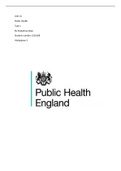Unit 12
Public Health
Task 1
By Madalena Adao
Student number 1316168
Mehjabeen S
, (P1)
This document describes the key aspects of public health strategies, a brief history of public
health in the UK, and a review of the historical and current features of public health. Show
how current patterns of ill health such as obesity, drugs, and sexually transmitted infections
(STIs) and how they are monitored. There are many reasons, such as social class, gender,
and lifestyle choices that can contribute to health inequalities in our days.
Monitoring the health status of the community
Monitoring the health status helps to track changes in the health of the community and
alert people to potential problems. For, example the Government is monitoring COVID – 19
deaths so the UK community is aware.
Identifying the health needs of the population
Concerning obesity, this means assessing the likely increase in the need for diabetes support
services determining priorities that incorporate clinical and cost-effectiveness and individual
perspectives.
Developing programmes to reduce risk and screen for early disease
Trying to reduce the levels of ill health by introducing new programmes that identify
individuals as being at risk of a condition. For example, a doctor identifying that someone is
at risk of developing referring them to a management programme for support or the WHO.
Controlling Communicable Diseases
Reducing the impact of infectious diseases through immunisation and other control
measures. For example, most high school, college, and universities provide safe sex talks to
the students to control the spread of STIs or the Government has produced Ads (Stay
Home*Protect the NHS*Save Lives) on the TV and all media about the COVID also to control
the spread of the virus.
Promoting the health of the population
Using health-promoting activities to reduce ill health in the population. For example, this
might include campaigns encouraging people to change to healthy behaviours like programs
addressing tobacco use to reduce lung cancer.
Planning and evaluating the national provision of the health and social care
Assessing the provision of relevant health services and whether they are having enough
impact to reduce ill health in the population. For example, mental health services can assess
whether or not did the patient get better? Did the patient feel satisfied with the service?
Has life expectancy increased in a certain age group?
, (P2)
Below show the health policies in British history, between the 19th to 21st century.
19th Century
Poor law Act 1834
Public health provision originated with the nineteenth-century Poor Law system. Poor Law
was amended in response to the 1832 Royal Commission into the Operation of the Poor
Laws chaired by the Bishop of London of Inquiry threw an investigation into the
administration of the Poor Laws in 1832. Then the Poor Law Commission was created in
1834, explored problems of community health, and suggested means for solving them. In
their report, the Commission made several recommendations to Parliament. The Act did
ensure that the poor had houses, clothes, and food and that children who entered the
workhouse would have the opportunity to go to school. But in return for this care, all
workhouses had to work for several hours a day.
First Public Health Act in 1848
Edwin Chadwick played a leading role in 1848 by creating the first law on public health to be
passed in the United Kingdom, the Public Health Act. He addressed several public health
issues including poor housing and working conditions and sanitary reform. Chadwick’s
Report on an inquiry into the sanitary conditions of the labouring population of Great
Britain, 1842 contained a mass of evidence linking environmental factors, poverty, and ill-
health. Six years later, the National Public Health Act (1848) was passed and the first Board
of Health was established.
The Cholera Outbreak in 1854
The Cholera Outbreak was a severe outbreak of cholera that occurred in 1854 near Broad
Street (now Broadwick Street) in the Soho district of the City of Westminster, London,
England, and occurred during the 1846–1860 cholera pandemic happening worldwide.
Cholera was a water disease that emerges from a bacterium called Vibrio cholera. John
Snow himself lived near Soho, immediately went to work to prove his theory that
contaminated water was the cause of the outbreak. In the middle 1800s, people didn’t have
running water or modern toilets in their homes. They used town wells and communal
pumps to get the water they used for drinking, cooking, and washing. Dr. Snow believed
sewage dumped into the river or cesspools near town wells could contaminate the water
supply, leading to more contamination. By plotting the cases of cholera on a map, Snow
established that all victims had all drank water from the pump in the street from a single
pump, which drew its supplies from the sewage-contaminated River Thames. People using
nearby wells to obtain their water had escaped infection. The connection between cholera
and contaminated water was therefore established before bacteriology was able to identify
the causative organism. Having identified the source of the infection as polluted water, he
went on to remove the handle of the Broad Street water pump and halted the outbreak of
cholera in Soho, London.





